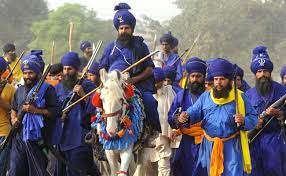18 Oct “Nihangs”

- Last year, a group of Nihangshad chopped off the hand of a policeman in Patiala with a sword after he asked them to show ‘movement passes’ during the Covid lockdown.
- This year, they have again killed a man near Singhu borderin New Delhi, allegedly for desecrating a sacred text.
Who is a Nihang?
- Nihang is an order of Sikh warriors.They are characterised by blue robes, antiquated arms such as swords and spears, and decorated turbans surmounted by steel quoits.
What does the word ‘Nihang’ mean?
- Etymologically the word nihang in Persian means an alligator, sword and penbut the characteristics of Nihangs seem to stem more from the Sanskrit word nihshank which means without fear, unblemished, pure, carefree and indifferent to worldly gains and comfort.
Origin:
- Sources trace their origin to Guru Gobind Singh’s younger son, Fateh Singh (1699-1705),who once appeared in the Guru’s presence dressed in a blue chola and blue turban with a dumala (piece of cloth forming a plume).
- On seeing his son look so majestic, the Guru remarked that it shall be the dress of Nihangs, the reckless soldiers of the Khalsa.
How were Nihangs different from other Sikhs, and other Sikh warriors?
- Nihangs observe the Khalsa code of conductin its strictest sense. They do not profess any allegiance to an earthly master. Instead of saffron they hoist a blue Nishan Sahib (flag) atop their shrines.
What is their role in Sikh history?
- Nihangs had a major role in defending the Sikh panth after the fall of the first Sikh rule (1710-15)when Mughal governors were killing Sikhs, and during the onslaught of Afghan invader Ahmed Sah Durrani (1748-65).
- Nihangs also took control of the religious affairs of the Sikhs at Akal Bunga (now known as Akal Takht) in Amritsar. They did not consider themselves subordinate to any Sikh chief and thus maintained their independent existence.
- Their clout came to an end after the fall of Sikh Empire in 1849when the British authorities of Punjab appointed a manager (sarbrah) for the administration of the Golden Temple in 1859.


No Comments